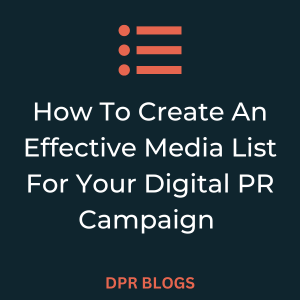I’m sure we can all agree that a solid media list is by far the most important part of any digital PR campaign. It’s the difference between the success or failure of your outreach, and will often take up the bulk of a PR’s time. If you’re new to digital PR strategy, you may be wondering if you need a media list and how to build one that’ll work. This guide will answer all your questions and help you to create a valuable press list that gets the results you’re after – with tips that’ll be useful to PR pros too.
What’s a media list?
Let’s begin by taking it back to the basics – what even is a media list? It does what it says on the tin – an organised list of your media contacts, and additional info like their contact details and news outlet. This may include journalists, bloggers, influencers etc. and is normally collated into a big spreadsheet for easy reference.
Essentially, it’s a collection of relevant people that might be interested in covering your story. Media lists are usually created for each individual campaign you’re outreaching, and targeted for that specific industry / and or location. It’s key for efficient digital PR as it allows you to approach the right journalists, and get a wider media pickup.
Why is it so important?
You might have gathered by now that a good media list is the real foundation of your strategy. But why exactly is that, and how is a media list better than alternative techniques?
🔗A media list goes beyond just identifying journalists, it helps you research their interests, define your target audience, and cultivate lasting relationships with relevant contacts – all in one place.
🔗Previously, sending out blanket press releases to a huge list of contact was a popular method, but that technique could damage your reputation and alienate journalists who aren’t interested in your story. Building genuine relationships with the right media contacts through a well-crafted media list will see you get far better results.
🔗Buying pre-built media lists is tempting, but short-sighted. These generic lists will often contain outdated information or irrelevant contacts. Creating your own list from scratch will mean you find journalists who cover your exact niche, increasing your chances of coverage.
A step-by-step guide to creating a media list
1.
Begin by setting up a spreadsheet and adding your chosen focus areas. As a basic starting point, start with the journalist’s name, ‘email’, ‘publication’ and ‘primary niche as columns. Other useful columns could include: links to social media accounts, topics covered, writing style etc and you can build this to be more detailed the more you do
2.
You’ll want to find journalists who’ve covered similar topics to your story; start by searching the title of campaigns similar to what you’re working on in Google News and filter by ‘past year’. Then, take relevant journalists’ names and copy them into the sheet. Avoid publications that do their own research, like ‘YouGov’, and play around with the terminology of the search to find all relevant results.
The key is to be super honed in on relevancy here. If you are writing a story about backpacking for students, there’s no point targeting all journalists who write about backpacking – writers on backpacking for retired couples wouldn’t be interested for example.
💡An additional tip is to look for sites that like to reference Digital PR links and data.
3.
Next, find a similar story from your competitor and input them into a backlink checker. See which publications and journalists are linking to this story, and add these names to your list.
Wondering where to find competitor campaigns? Email newsletters are a good starting point to find successful, recent competitor campaigns. The PR Insider and The Grapevine are conveniently organised by category, making it nice and easy for you to locate stories in the same vein as the release you’re working on. It’s also worth looking at Twitter and LinkedIn because one thing PRs love is a humble brag about a campaign that’s done well.
4.
Once you’ve got a decent amount of names, go back and fill in the ‘name’ and ‘email’ column for each link. Journalists will sometimes have their email on their online author profile, or you can use a tool like Vuelio, or Prowly to find their details.
5.
Finally, download and export the file into an outreach tool like Buzzstream or CisionOne, and that’s good to go.
It’s important to remember that a media list is never really completed! The most effective lists are actively maintained and updated with new contacts, and updated contact information.
Guarantee media coverage for your business with Cedarwood Digital
We’re Cedarwood Digital, a digital PR agency based in Manchester, with a proven track record of delivering earned links for brands – even those in the trickiest verticals! We’re proud to say that we don’t buy a single link and you can see the coverage we’ve landed in our case studies here.
If you’re looking for a hand with your digital PR strategy or you want to explore white-label digital PR agency options, go ahead and get in touch with us today, we’d love to hear from you.

